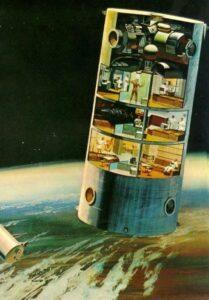Recently I have been watching the TV series “The Expanse”, and greatly enjoying it.
Naturally enough, this reminded me of this section of the Atomic Rockets website, and the comment “…they actually have their spacecraft laid out like a skyscraper, the way God and Heinlein intended.”
The skyscraper element is not that obvious in the series. Many of the interior shots suggest an elongated form.
Skyscrapers in Space
Constructing a space vessel like a skyscraper or tower is consistent with settings such as Transhuman Space, where there is not the convenience of artificial gravity or similar contrivances.
It is also an interesting curve-ball to throw at players who are used to the long spaceship corridors usually shown in science fiction.
Space crews in Transhuman Space spend most of their time in micro-gravity, but will experience a sensation of gravity when under acceleration, even though the large interplanetary manned vessels have accelerations of only 0.05 to 0.2 G. These two conditions will affect the internal architecture of the space vessel.
What does this mean in practice?
For one thing, a ship is likely to have lots of decks, but each will not be particularly spacious.
GURPS Spaceships 8, 4e. describes spherical THS space vessels of 95 to 100 feet diameter (Lewis-HSTV and Königsberg-SDV), and a space defence platform (Shanzi-SDP) of 124 feet.
Most THS space vessels are cylindrical, however. Spaceships 8 gives lengths, but not diameters. Spaceships of the Solar System 3e. gives more detailed dimensions.
Large vessels such as SCV and SDV may be 375 to 450 feet long, but are 50 feet in diameter.
Smaller vessels such as Mojave ESV are 100 feet long and 25 in diameter.
Floor area of a single space vessel deck will be less than 176 hexes, and the deck less than 15 yards across.
Humans and parahumans born to micro-gravity tend to be on the tall side, so it is reasonable to assume that distance between deck and ceiling will remain the standard 10 feet apart.
Some space vessels will thus resemble 30 or 40 storey buildings.

The Conduit: Backbone of a Space Vessel
With so many decks, it is reasonable to conjecture that there is some means to easily and rapidly move between them.
I imagine this as a shaft or tube that passes through most, or all, of the decks.
This “conduit” or “central well” could pass down the central axis of a ship, resulting in annular decks.
It may be more practical to run the conduit down one side of the vessel to give a more useful deck area. The side of the ship with the conduit is usually designated the “dorsal” side of a deck, and the other three directions relative to this ventral, port and starboard.
“Down” or “aft” is the part of the vessel where the drive is located. When under thrust this is the direction objects will drop and crew will feel as down.
Cabins and significant structures on the port side are given odd numbers, those on the starboard, even.
Numbering is consecutive, in order from dorsal to ventral, inboard to outboard, fore to aft (modified from GURPS Traveller Starships 3e p.25). Cabin or corridor numbers are often preceded by a deck number. Decks are numbered in ascending order from fore to aft.
For any deck, the lower location numbers will therefore be nearest the centre of the dorsal side.
When in free-fall, the quickest way to get between decks is to drop, free-fall or fly-float up or down the conduit.
In free-fall, the conduit will be perceived as a horizontal tunnel rather than a vertical shaft.
The interior walls of the conduit have various handholds which can be used to accelerate the free-faller, or used to swing through an opening and exit the conduit. These are distinctively painted so they can easily be spotted. Some will glow if the main lighting fails, and may even double as emergency lighting fittings.
Exits from the conduit may be surrounded by padded areas to cushion spacers that misjudge their speed. In a dorsally positioned conduit, the exits will be on the ventral side.
When under acceleration, it is still possible to drop down the conduit, at least in the smaller or slower vessels.
To ascend, the conduit contains tracks for one or more lift cars, essentially small maglev vehicles. It would seem prudent to have a least two passenger cars.
A larger freight elevator or platform may also be available. The latter would be useful moving particularly massive loads along the conduit when in free-fall.
Some ships have winches at either end of the conduit, allowing loads to be hauled up or down.
The conduit walls would also include at least one ladder.
The conduit is literally a conduit, being the main route for plumbing, power supply and data lines of the vessel to pass between decks. Access panels are a common feature of conduit walls and it is usual to see maintenance robots or cyberswarms “while taking the tube”.
The conduit may be referred to by various nicknames and slang terms, including Main Street, the Mainline, Broadway, Spaccanapoli and (Grand) Canalazzo.